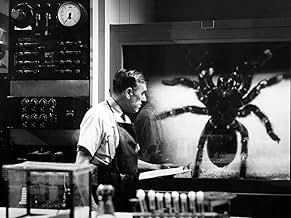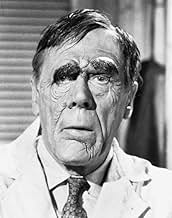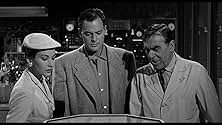AVALIAÇÃO DA IMDb
6,4/10
11 mil
SUA AVALIAÇÃO
Uma aranha escapa de um laboratório isolado do deserto do Arizona com gigantismo, e cresce a um tamanho tremendo à medida que leva o caos aos habitantes locais.Uma aranha escapa de um laboratório isolado do deserto do Arizona com gigantismo, e cresce a um tamanho tremendo à medida que leva o caos aos habitantes locais.Uma aranha escapa de um laboratório isolado do deserto do Arizona com gigantismo, e cresce a um tamanho tremendo à medida que leva o caos aos habitantes locais.
- Direção
- Roteiristas
- Artistas
- Prêmios
- 1 vitória no total
Benjie Bancroft
- Trooper
- (não creditado)
Wag Blesing
- Townsman
- (não creditado)
Dee Carroll
- Telephone Operator
- (não creditado)
Edgar Dearing
- Second Tramp
- (não creditado)
George DeNormand
- Arizona State Trooper
- (não creditado)
Don Dillaway
- Jim Bagny
- (não creditado)
Stewart East
- Trooper
- (não creditado)
Clint Eastwood
- Jet Squadron Leader
- (não creditado)
Avaliações em destaque
As someone who'll kill a common house spider on sight, and as a resident of one of the the cooler regions of the United States, I try to watch the fifties sci-fi movie Tarantula whenever it's on. Maybe I do it as therapy. I dunno. Or maybe I'm trying to convince myself that it really is better living in a city that has been known to have blizzards in April. Whatever. But enough about me. This Jack Arnold-directed movie was made for Universal-International at a time that studio wasn't nearly the behemoth it is today. But U-I, or rather its management, wanted to be big, and were aiming to grow. Kind of like the eight-legged creature in this film.
The movie is set in an Arizona desert town whose handsome young Dr. John Agar is trying to solve the mysterious death of a man from a condition known as acromegaly (or acromegalia, as it's called in the film). His quest takes him to the laboratory of research scientist Leo G. Carroll, who, though outwardly polite, clearly doesn't want to be bothered. He doesn't want his beautiful young assistant, Mara Corday, to be bothered, either, least of all by the romantic Dr. Agar.
As luck would have it, Carroll and his former associate and friend,--let's call him the acromegaly man, and leave it at that--were working on a nutrient, a growth formula, that they hoped would cure world hunger. To make a long story short, one of the creatures they were experimenting on, a tarantula already the size of a Volkswagon, escaped from the lab when a former assistant, also suffering from acromegaly, set it on fire, as he had gone mad. He also injected Dr. Carroll with the growth formula that would in time give him acromegaly, too.
In a brief period of time the spider has grown to the size of a house, then an office building. He's either very shrewd or very lucky to avoid being spotted, feasting mostly on ranchers and men in remote areas where he won't be seen by others. Guns are useless against the big guy. Dynamite can't kill him, either. He just ambles on right through it. The Air Force has to be called in. I won't tell you any more because I don't want to spoil the ending for you.
As big bug movies go, this one's near the top of my list. It's very well photographed, and the life of the small town is presented with just enough credibility so that even when the story gets a tad weird, the people seem real. I especially liked Nestor Paiva's extremely (to put it mildly) aggressive performance as the sheriff. Forceful as he is, he's never obnoxious, just assertive. Mara Corday doesn't have much to do but look pretty, which she does superbly. The late John Agar is quite good as the town doctor. No, this isn't George C. Scott we're talking about, but Agar is competent. Also, there's something about his looks, the eyes and cheekbones especially, that give him an alien, almost unreal aspect. It's a perfect face for a fifties sci-fi hero. Slightly android.
Leo G. Carroll is his usual diffident self, and he does make a convincing scientist. There's something about Carroll's manner and delivery of dialog that makes you want to hear more. I wish he'd have more to say and more to do, and not just in this movie, in all the movies he appeared in. This isn't exactly a star vehicle for him, but his role is substantial, and in a way it's his low-key underacting that keeps the movie anchored in something that resembles reality. Put a more flamboyant type in the part, a Rathbone or a Lugosi, and the film would be over the top.
The movie is set in an Arizona desert town whose handsome young Dr. John Agar is trying to solve the mysterious death of a man from a condition known as acromegaly (or acromegalia, as it's called in the film). His quest takes him to the laboratory of research scientist Leo G. Carroll, who, though outwardly polite, clearly doesn't want to be bothered. He doesn't want his beautiful young assistant, Mara Corday, to be bothered, either, least of all by the romantic Dr. Agar.
As luck would have it, Carroll and his former associate and friend,--let's call him the acromegaly man, and leave it at that--were working on a nutrient, a growth formula, that they hoped would cure world hunger. To make a long story short, one of the creatures they were experimenting on, a tarantula already the size of a Volkswagon, escaped from the lab when a former assistant, also suffering from acromegaly, set it on fire, as he had gone mad. He also injected Dr. Carroll with the growth formula that would in time give him acromegaly, too.
In a brief period of time the spider has grown to the size of a house, then an office building. He's either very shrewd or very lucky to avoid being spotted, feasting mostly on ranchers and men in remote areas where he won't be seen by others. Guns are useless against the big guy. Dynamite can't kill him, either. He just ambles on right through it. The Air Force has to be called in. I won't tell you any more because I don't want to spoil the ending for you.
As big bug movies go, this one's near the top of my list. It's very well photographed, and the life of the small town is presented with just enough credibility so that even when the story gets a tad weird, the people seem real. I especially liked Nestor Paiva's extremely (to put it mildly) aggressive performance as the sheriff. Forceful as he is, he's never obnoxious, just assertive. Mara Corday doesn't have much to do but look pretty, which she does superbly. The late John Agar is quite good as the town doctor. No, this isn't George C. Scott we're talking about, but Agar is competent. Also, there's something about his looks, the eyes and cheekbones especially, that give him an alien, almost unreal aspect. It's a perfect face for a fifties sci-fi hero. Slightly android.
Leo G. Carroll is his usual diffident self, and he does make a convincing scientist. There's something about Carroll's manner and delivery of dialog that makes you want to hear more. I wish he'd have more to say and more to do, and not just in this movie, in all the movies he appeared in. This isn't exactly a star vehicle for him, but his role is substantial, and in a way it's his low-key underacting that keeps the movie anchored in something that resembles reality. Put a more flamboyant type in the part, a Rathbone or a Lugosi, and the film would be over the top.
In Desert Rock, Arizona, a disfigured man is found dead and identified by Professor Gerald Deemer (Leo G. Carroll) as his assistant and friend Dr. Eric Jacobs, who would suffer from acromegalia. The country doctor Matt Hastings (John Agar) is puzzled with the mysterious disease and decides to investigate further about acromegalia. Professor Deemer omits that Dr. Eric Jacobs and Dr. Paul Lund were researching with him a nutrient to increase the food supply in the world and they have been affected by the experiment. Soon Paul Lund, who has also been affected and is mad, breaks and sets the laboratory on fire and a huge tarantula escapes.
Meanwhile, the gorgeous Stephanie "Steve" Clayton (Mara Corday) arrives in town to work with Dr. Jacobs, and Dr. Hastings drives her to Professor Deemer's house in the desert. She is hired by Deemer and she finds that he is sick. When cattle bones are found in a farm, Hastings collects material and flies to a laboratory, where he learns that the sample is of tarantula's venom. But the scientist does not believe that one tarantula could ever produce such quantity of venom. The doctor returns to Desert Rock sure that the species is part of Prof. Deemer's experiment and the locals are threatened by the dangerous tarantula.
"Tarantula" is a typical sci-fi of the 50's and a surprisingly good film. The screenplay is very well written and the movie is supported by good direction, performances, cinematography and special effects. My vote is seven.
Title (Brazil): "Tarântula!" ("Tarantula!")
Note: On 16 Sep 2018 I saw this film again.
Meanwhile, the gorgeous Stephanie "Steve" Clayton (Mara Corday) arrives in town to work with Dr. Jacobs, and Dr. Hastings drives her to Professor Deemer's house in the desert. She is hired by Deemer and she finds that he is sick. When cattle bones are found in a farm, Hastings collects material and flies to a laboratory, where he learns that the sample is of tarantula's venom. But the scientist does not believe that one tarantula could ever produce such quantity of venom. The doctor returns to Desert Rock sure that the species is part of Prof. Deemer's experiment and the locals are threatened by the dangerous tarantula.
"Tarantula" is a typical sci-fi of the 50's and a surprisingly good film. The screenplay is very well written and the movie is supported by good direction, performances, cinematography and special effects. My vote is seven.
Title (Brazil): "Tarântula!" ("Tarantula!")
Note: On 16 Sep 2018 I saw this film again.
Only slightly less classic than "Them!" "Tarantula" still manages to stand on its own as a strong entry in the Giant Bug movies of the 50s. Technically, its not a bug movie as tarantulas are arachnids and not insects, but movie-going audiences of the 50s didn't care. They just wanted to see big ugly bugs crushing everything in their path, and this film certainly delivers in that respect.
Taciturn scientist Leo G. Carroll is a man bent on finding a cure for world hunger. He invents a serum which enlarges whatever animal or insect (or arachnid) it is injected into. Unfortunately, when injected into a human, it causes acromegalia, a disorder marked by progressive enlargement of the head, face, hands, feet, and thorax, due to the excessive secretion of growth hormone. When one of Leo's human guinea pigs comes looking for revenge, he not only destroys the lab and injects the doctor with his own serum, but he shatters the glass cage of a puppy-sized tarantula, which quickly scurries out into the night.
Enter Mara Corday and John Agar. Mara Corday is the new lab assistant for Leo, and John Agar is the country doctor who takes an interest in the dark haired beauty. But there's not much time for romance as the tarantula, now roughly the size of the Goodyear blimp, begins terrorizing the desert. Farm animals are munched upon, and so too are human victims who are found in pools of venom, their bodies literally filled with enough poison to kill ten more men besides. Leo G. Carroll slowly turns into the Elephant Man, the giant spider peeks through the window at Mara in her nightie and Clint Eastwood shows up at films end to fire napalm at the eight legged menace.
Forget about "Earth vs. The Spider" and whatever you do, avoid "The Giant Spider Invasion" at all costs. This is the definitive Giant Spider film. It's smart and fast and well acted, and the spider itself is pretty cool looking, considering the fact that no furry robotic arachnids were constructed for this film, but instead film footage of a real tarantula was blown up and rear projected. It looks pretty good, considering the time. If you liked "Them!" you'll definitely want to check this one out as well.
Taciturn scientist Leo G. Carroll is a man bent on finding a cure for world hunger. He invents a serum which enlarges whatever animal or insect (or arachnid) it is injected into. Unfortunately, when injected into a human, it causes acromegalia, a disorder marked by progressive enlargement of the head, face, hands, feet, and thorax, due to the excessive secretion of growth hormone. When one of Leo's human guinea pigs comes looking for revenge, he not only destroys the lab and injects the doctor with his own serum, but he shatters the glass cage of a puppy-sized tarantula, which quickly scurries out into the night.
Enter Mara Corday and John Agar. Mara Corday is the new lab assistant for Leo, and John Agar is the country doctor who takes an interest in the dark haired beauty. But there's not much time for romance as the tarantula, now roughly the size of the Goodyear blimp, begins terrorizing the desert. Farm animals are munched upon, and so too are human victims who are found in pools of venom, their bodies literally filled with enough poison to kill ten more men besides. Leo G. Carroll slowly turns into the Elephant Man, the giant spider peeks through the window at Mara in her nightie and Clint Eastwood shows up at films end to fire napalm at the eight legged menace.
Forget about "Earth vs. The Spider" and whatever you do, avoid "The Giant Spider Invasion" at all costs. This is the definitive Giant Spider film. It's smart and fast and well acted, and the spider itself is pretty cool looking, considering the fact that no furry robotic arachnids were constructed for this film, but instead film footage of a real tarantula was blown up and rear projected. It looks pretty good, considering the time. If you liked "Them!" you'll definitely want to check this one out as well.
I enjoyed this film, which was one of the best of the "giant, mutated one-thing-or-another" movies. Two of my favorites of the 1950 B-movies, John Agar and Nestor Paiva starred with Mara Corday(who is very beautiful). Hank Patterson was great as Josh the hotel clerk, who provided comic relief. Clint Eastwood has a small part at the end of the film as the fighter squadron leader. The effects by Clifford Stine are classic and Jack Arnold again proves his worth as director(before moving on to the "Brady Bunch" in the 1960s). Leo Carroll is superb as Professor Deemer, who develops a formula for a growth serum. It is this serum(with uses an atomic isotope)that produces rapid growth in all the lab animals,including the Tarantula. The acting is very good, the movie has a nice pace and the effects for their time are top-notch. This is one 1950s sci-fi film to see!
This is a top-of-the-line Sci-Fi thriller from the studio that did 'em best in the 1950s - Universal-International. Produced by William Alland (who also produced "Creature From the Black Lagoon" and "It Came From Outer Space", and directed by Jack Arnold (who directed those films) it has an intelligent script and good acting all the way around. Arnold does a great job of building suspense as he cleverly keeps the titular monster mostly off-screen for the first 2/3 of the film until it's simply too big to hide. And then --- watch out, folks! As in many another sci-fi story, the road to hell is paved with good intentions, and if there's a villain of the piece, it's the Nuclear Age - the spider of the title is merely doing it's natural thing: searching for food. Except that, thanks to Leo G. Carroll's well-meaning experiments (to increase the world's supply of food), this is one BIG spider with an equally BIG appetite! Universal's special effects department just about out-did themselves here - the matte work is almost flawless (check out Leo G. Carroll's house after the spider's visit), and the make-up department did excellent work as well. This is one of the best of it's kind, and great fun on a rainy Saturday afternoon.
Você sabia?
- CuriosidadesThe spider that portrayed the giant tarantula later appeared in O Incrível Homem que Encolheu (1957) as the spider threatening the shrinking man.
- Erros de gravaçãoProf. Deemer takes special care to fill the hypodermic needle inside an isolation box wearing rubber gloves; however, once filled, he pulls it out of the box with his bare hands and then removes air from the needle by shooting a little bit of serum out. Had the toxicity of the serum been that dangerous, he probably would have done that with the needle still in the box and would have worn gloves while handling the needle outside the box.
- Citações
Stephanie 'Steve' Clayton: Science is science, but a girl MUST get her hair done.
- ConexõesEdited into Attack of the 50 Foot Monster Mania (1999)
Principais escolhas
Faça login para avaliar e ver a lista de recomendações personalizadas
- How long is Tarantula?Fornecido pela Alexa
Detalhes
Bilheteria
- Faturamento bruto nos EUA e Canadá
- US$ 1.100.000
- Tempo de duração
- 1 h 20 min(80 min)
- Cor
Contribua para esta página
Sugerir uma alteração ou adicionar conteúdo ausente




































